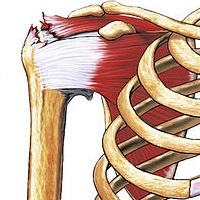
Photo from wikipedia
Background: Single-row (SR) and double-row repair techniques have been described to treat rotator cuff tears. We present a novel surgical strategy of arthroscopic-assisted mini-open repair in which a locking-loop suture… Click to show full abstract
Background: Single-row (SR) and double-row repair techniques have been described to treat rotator cuff tears. We present a novel surgical strategy of arthroscopic-assisted mini-open repair in which a locking-loop suture bridge (LLSB) is used. Purpose: To compare the functional outcomes and repair integrity of LLSB technique to the SR technique for arthroscopic-assisted mini-open repair of small to medium rotator cuff tears. Study Design: Cohort study; Level of evidence, 3. Methods: Included were 39 patients who underwent LLSB repair (LLSB group) and 44 patients who underwent SR suture anchor repair (SR group) from 2015 to 2018. We evaluated all patients preoperatively and at 3, 6, 12, and 24 months postoperatively using the visual analog scale (VAS) for pain, Oxford Shoulder Score (OSS), and American Shoulder and Elbow Surgeons (ASES) score. Also, shoulder sonography was performed at 12 months postoperatively to evaluate repair integrity using the Sugaya classification system. The independent-sample t test was used to analyze functional outcomes (VAS, OSS, and ASES scores), and the Fisher exact test was used to analyze postoperative sonography results. Results: Patients in both the LLSB and SR groups saw a significant improvement on all 3 outcome measures from preoperatively to 24 months postoperatively (P < .001 for all). However, when comparing scores between groups, only the scores at 3 months postoperatively differed significantly (VAS: P = .002; OSS: P < .001; ASES: P = .005). Shoulder sonography at 12 months postoperatively revealed no significant difference in repair integrity between the LLSB and SR groups (retear rate: 10.26% and 6.82%, respectively; P = .892). Conclusion: Better outcome scores were seen at 3-month follow-up in the LLSB group, with no difference in retear rates compared with the SR group at 12 months postoperatively. The LLSB technique was found to be a reliable technique for rotator cuff repair of small- to medium-sized tears.
Journal Title: Orthopaedic Journal of Sports Medicine
Year Published: 2023
Link to full text (if available)
Share on Social Media: Sign Up to like & get
recommendations!